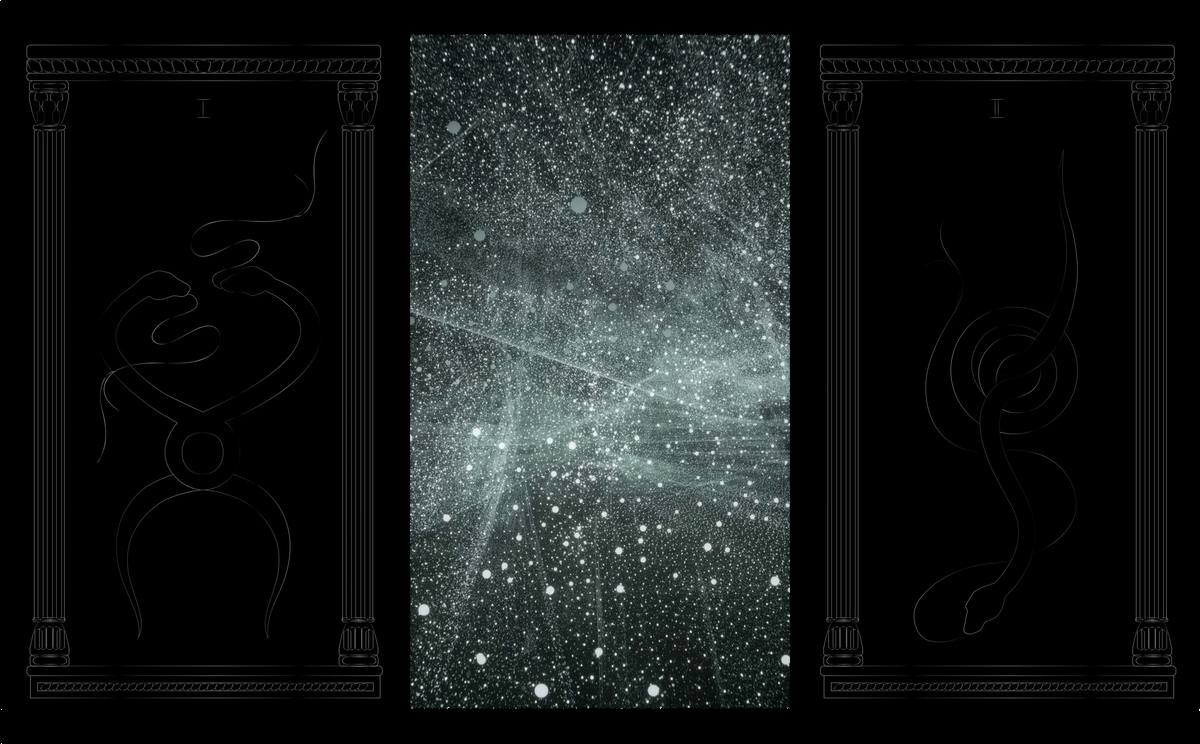Ancient numerology, apocalyptic prophecy and contemporary geopolitics collide in the final instalment of LABOUR’s Fact residency.
The visual component to LABOUR’s second major performance piece, Mi†ra presents ‘nine-sum sorcery’, is divided into three chapters that closely follow the writing of Iranian philosopher Reza Negarestani in his 2008 book Cyclonopedia: Complicity with Anonymous Materials. The book centers on the fictional archaeologist and professor of ancient mathematics Hamid Parsani, whose disappearance under mysterious circumstances leads to the discovery of his research, chaotic notes obsessed with the idea that oil can be understood as a kind of esoteric lubricant for horrific events in the Middle East.
Approaching oil as a creeping sentient entity, dubbing it, variously, as “hydrocarbon corpse juice”, “the Tellurian Lube” or “the Devil’s Excrement”, Parsani’s preoccupation with the geopolitics of petroleum throughout history collides with his expertise in ancient numerology in his search for the Cross of Akht, the sign of an ancient artefact said to be “the flowing source of the black flame”.
It is from this component of Parsani’s fictitious research that Mi†ra draws the titles for each chapter of ‘nine-sum sorcery’, ‘The Wheel’ (“machines are digging”), ‘Cyclone’ (“ancient without tradition”) and ‘Xerodome’ (“deities breath dust and sear worlds”). Artists Evelyn Bencicova and Enes Güc create imagery and animation in response to these phases, which in Cyclonopedia follow the oil’s journey as it is drawn from the earth via pipeline into the dust and heat of the desert. This is preceded by Zeynep Schilling‘s occult calligraphy, or “snake-writing”, that spells out the title of the performance.



It is in the final chapter, ‘Xerodome’, that Mi†ra combines the disparate elements that Reza Negarestani weaves together to make up the notes of the fictional professor Parsani. By using a “numogramatic decimal progression”, Parsani is able to decode the Cross of Akht as a sign counting down to an apocalyptic event foretold in the ancient legend of Gog and Magog, monstrous figures that will be unleashed at the end of time.
This “nine-sum” countdown is where Mi†ra take the name of their performance, a countdown at the end of which the terrible power imbued within oil will be released upon the earth in one final catastrophe or, as Parsani cryptically explains: “the Gog-Magog axis implodes on Zero and the desert of the Xerodome is born.”
We find ourselves in the midst of this desert in the final chapter of ‘nine-sum sorcery’, a place where “deities breathe dust and sear worlds”, surrounded by the refined horrors of oil, “an object of desire and the means of destruction” that is, in the words of Reza Negarestani, at once “narrative…lubricant”, “a pipeline crawler” and “holy water”.



In this apocalyptic wasteland all that draws power from the earth and the oil beneath it is reduced to dust, the dry remnants of the civilizations that have been created and destroyed with its dark power. “Dust is a real nomadic entity”, explains Negarestani, “it migrates elsewhere, spiriting itself away as an illusive ground. When dust particles are composed, they combine countless terms, languages and materials belonging to entirely different kingdoms.”
Farahnaz Hatam harnessed the algorithmic compositional power of SuperCollider (digital sound synthesis programming environment) to build a unique granular synthesis ‘instrument’, that applies various techniques on short fragments of Hani’s voice, now finally ‘disembodied’ in the final section of the work – utilising cloud formations, algorithmic composition, stochastic distributions and weighted randoms to sculpt the various processes and timings of sonic events.
This unique application of granular synthesis was chosen to link conceptually to the dust and particles of the desert of the Xerodome. On the macro compositional level, the drumming section immediately preceding the final chapter reinforces the musical idea of stochastic distribution – or shifting densities, via a non-grid-time approach to rhythm that still follows a precise cyclical notion of time . The very end of the piece utilises psycho-acoustic techniques to push-out of the density and enhance the final moments of metastasis
For more information about LABOUR and their work you can follow them on Instagram and visit Farahnaz Hatam and Colin Hacklander’s website.
Watch next: LABOUR Presents: nine-sum sorcery – Part One




